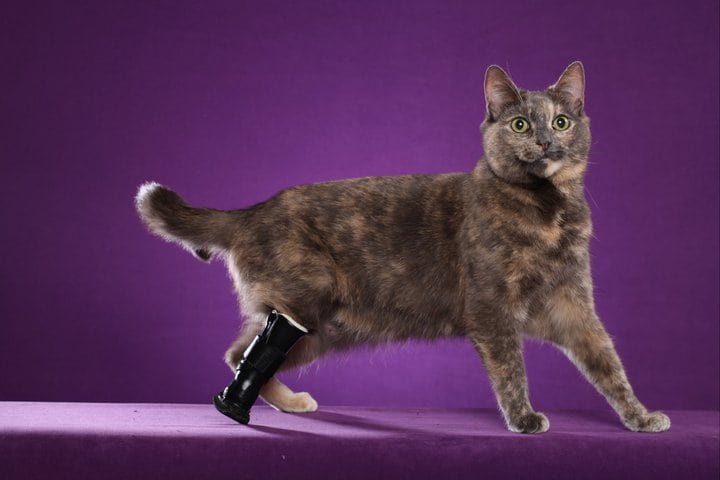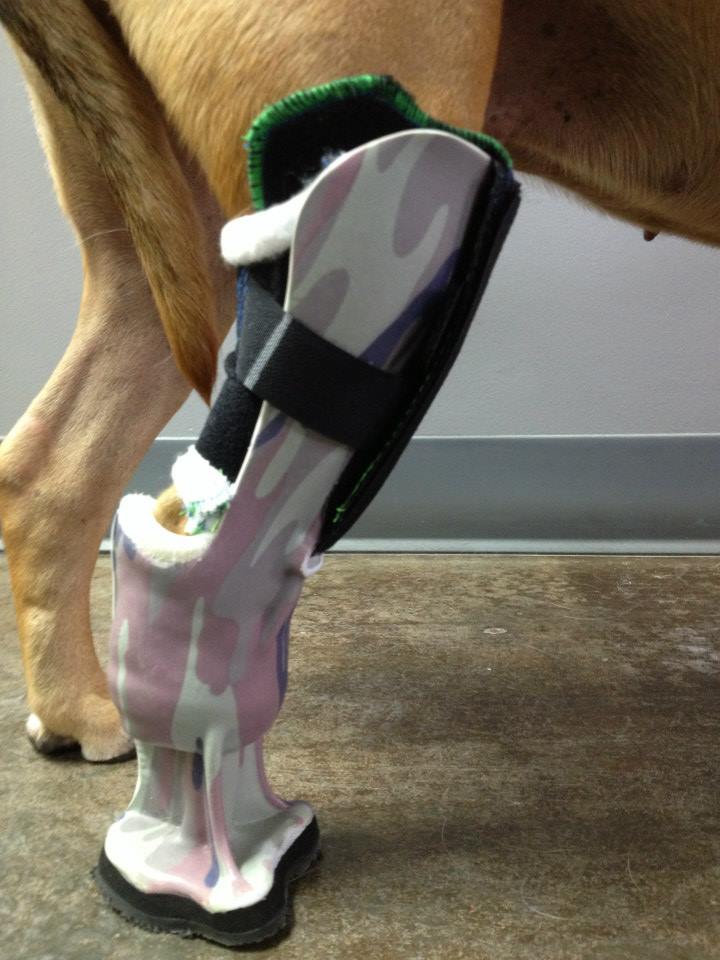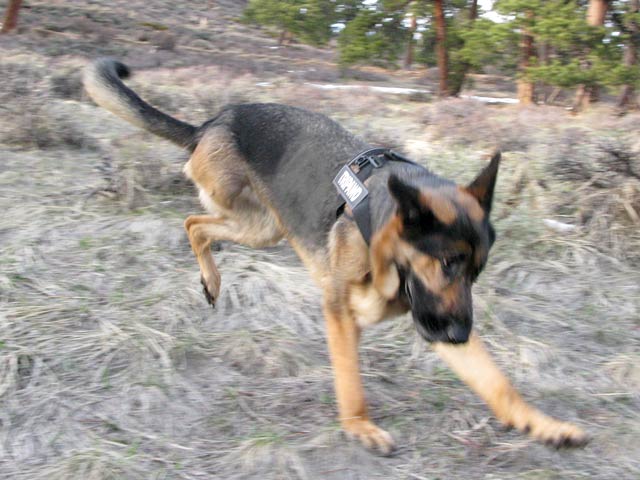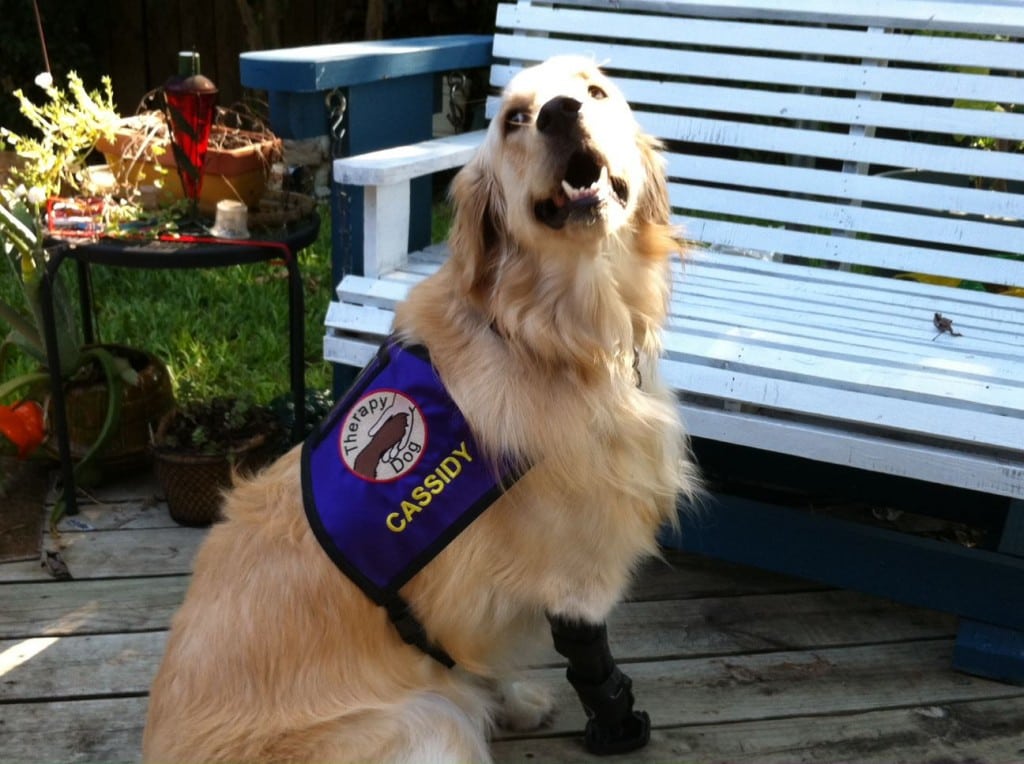Learn About Prosthetics and Braces for Tripawds:
An Interview with OrthoPets co-founder Martin Kaufmann (Part 1 of 2)

If your dog, cat or other animal companion has to lose a leg, you’ve probably considered an animal prosthetic device.
After all, everyone wants their animal to have a great quality of life, and if humans can have a better one with an artificial limb, then it makes sense that animals can too, right?
Since our founding in 2006, Tripawds members have consistently asked questions about prosthetic devices. Most of us have wondered:
- What are some of the pros and cons of prosthetics for pets?
- Is my pet a prosthetic candidate?
- How do you train an animal to use a prosthetic?
- What do prosthetics cost?
A few Tripawds members have tried prosthetic limbs and their experiences are as varied as each individual Tripawd’s journey. Our Discussion Forums regularly have questions about prosthetics, which is why we were thrilled when we had the opportunity to meet Martin Kaufmann, ABC CPED, owner and co-founder of OrthoPets, the only certified Veterinary Orthotics and Prosthetics (V-OP) Veterinary Clinic in the entire world that just works on animals.

Kaufmann and his wife, Amy (pictured here) started OrthoPets in 2007 and have been worldwide leaders in animal prosthetics ever since.
Get the Facts About Prosthetics for Animals
We recently met with Kaufmann at Colorado State University’s Veterinary Teaching Hospital for an educational discussion to get the facts about prosthetics for animals.
We learned about about how prosthetics are designed, when and how they can benefit three-legged animals. We’re happy to share this enlightening conversation with you in the following two part series.
In this first video interview, Kaufmann discusses:
- Who’s a good candidate for a dog or cat prosthetic
- Which dogs and cats with limb deformities can use prosthetics
- How quickly pets adapt after getting a prosthetic
- What kind of commitment is required to train a pet with a prosthetic
After the video, read on for more OrthoPets facts about animal prosthetics and be sure to catch part two of our interview with OrthoPets.
Tripawds Can Be Awesome
As a certified prosthetic designer, Kaufmann agrees that Tripawds can get along well without a prosthetic. “I think a three-legged dog absolutely can do fine,” he reassures us. But he adds:
“I don’t settle for fine though. I think fine is good, but I think great is awesome.”

With proper evaluation by a unified team consisting of a veterinarian, a rehabilitation therapist, a prosthetician and a pet parent who’s willing to make a long-term commitment to rehabilitation therapy, a device from OrthoPets can improve a Tripawd’s quality of life by taking stress off the remaining limbs and decreasing the chances of long-term injuries caused by the modified stance and gait that all Tripawds develop over time.
Evaluating the Potential for Injury
Rehabilitation therapists have told us before: all Tripawds have a greater potential for developing chronic aches, pains and injuries than their four-legged counterparts. However some breeds are at greater risk than others, which Kaufmann reiterated to us.
“Breeds really play a large part in what could go on” he says. The extent of a potential or actual injury depends on the natural stance of that breed. For example, a German Shepherd dog has a completely different stance than a Bulldog – with or without a missing leg.

Once a leg is removed, each breed has a different way of compensating for that missing limb. Some compensate more than others but no matter what kind of dog is affected, over time a Tripawd will experience more pronounced physical issues.
When it comes to comparing the potential for injury between front and rear leg Tripawds, Kaufmann says that front-leg Tripawds are generally at a greater risk of orthopedic issues. That’s because dogs naturally bear 60 percent of their weight on their two front limbs: when they lose a front limb, the remaining one is left to perform the majority of the work.
On front-leg Tripawds, this work is performed by the carpus (the dog’s “wrist”). As a front-leg Tripawd ages, bearing the extra weight can lead to carpus joint problems.
[vimeo]http://vimeo.com/12586421[/vimeo]
“The carpus in the canine is such a mobile joint, and it has so much potential for injury,” he explains. “The soft connective tissues – the ligaments, the joint capsules, those types of structures – are built to do a job with a certain load in a certain orientation. You start placing legs in an inappropriate alignment, add more force, and . . . now we’re going to experience long term trauma.”
“It’s hard to be objective about what that really means but there’s a price to pay,” says Kaufmann. Although no verifiable data currently shows which breeds will pay what specific price for being a Tripawd, “we know that there is an effect,” he explains.
[vimeo]http://vimeo.com/12534571[/vimeo]
As for rear-legged Tripawds, they have it a little easier because less load-bearing occurs on the remaining rear limb. Still, they too will likely encounter their own unique challenges, such as putting extra stress on an already-compromised cruciate ligament. And while OrthoPets devices can help rear-limb amputees in many situations, Kaufmann explains that
“We really put a higher value on being awesome when missing a front leg, because that’s more challenging and far more complicated.”

In our second video interview with OrthoPets, you’ll learn more about prosthetic limbs for dogs and other animals such as:
- How orthotic braces can help front and rear Tripawds
- Which breeds are most affected by the loss of a limb
- When a brace is most beneficial
- Determining which brace is best for your Tripawd
- How to mitigate the effects of life as a dog or cat amputee
Please give a big three paws up to Martin Kaufmann and the good people of OrthoPets for helping to improve quality of life for all dogs, cats and other amputee animals.
If you think your Tripawd might benefit from an OrthoPets prosthetic, visit the OrthoPets website for details.
A lady in the next county contacted me privately because if my love of Golden’s. She had a puppy born without his right front foot. She thought she could take care of him but recently had unexpected medical things happen. So, I took him in and we love him dearly. He gets around ok, he hops around, goes up and down stairs and even runs like the wind! But I worry about the damage it’s doing to his shoulder and joints and would like more info on maybe getting him a prosthetic. He’s not even a year old so he’s still gonna grow. I am in unknown territory and could use some ideas and help. Thank you!
Barb we highly recommend taking him for an evaluation with an orthopedic vet, who can assess him for areas that may be problematic as he grows. He does sound like an ideal candidate for a prosthetic too. Please check out our blog posts about orthopedic insight for Tripawds and join our discussion forums when you get a chance. We look forward to following along with your journey.
My cat just had his left rear leg amputated. They cut it at the hip joint to make recovery faster on him. Would he be able to use a prosthetic that is not a wheel?
So sorry to hear about your cat! Functional prosthetic devices require at least one articulating joint, and ideally two. See our various other videos and podcasts abut prosthetics for more information. Fortunately, the vast majority of trikitties recover quickly and adapt well to life on three legs. Don’t miss the many helpful tips for three legged cats and post in the forums for much more feedback from others.
My Chihuahua broke her toes and the vet is recommending amputation of the front leg, she wants to amputate the whole thing, but I think she would be a good candidate for a prosthetic . Whats the cost of that and how do I go about getting her one, I live in Texas
Stacy
Stacy, that is a question for OrthoPets. They work with vets all over the country so have your vet give them a call if they don’t already have an existing relationship. Good luck, I hope it works out.
Hi!
One of my cats lost most of his rear left foot after a battle with infection. He is in good health now and much better spirits, but he is obviously having a more difficult time getting around and in a way that looks like it could do damage to his back in the long term.
He is less than 3 years old and otherwise healthy.
He still has the ankle on this leg.
It seems like he’d be a good candidate for a prosthetic.
What is the process for getting him one?
Thanks!
Alona, please contact Orthopets! They have an intake form on their website with everything you need to know.
My daughter has a 4 year old partial pit, partial ??? She was born with a deformed left rear foot. The vet decided to amputate her entire leg and hip. Lately the dog seems to suffer a lot of pain and will drag it’s back portion along when moving. It’s really quite sad to watch. My daughter said the dog can not be fit for a prosthetic because she does not have a hip. Do you know of any device that may benefit this dog? My daughter and her dogs live in SLC, UT.
Thank you,
JuDee
Thanks for commenting JuDee. Your daughter is correct, it is too late for a prosthetic device. What her pup needs right now is proper rehab and regular conditioning to build core strength and strengthen remaining limb muscles. Please download Loving Life On Three Legs for lots of helpful tips and how to videos, or consider consulting with a certified rehab vet/tech for a professional evaluation and DIY exercises you can do at home. She may even be eligible for reimbursement from the Tripawds Foundation Maggie Moo Fund.
Sir please help me to find prosthetic for my pet she lost one of her leg partially in an accident , day before yesterday please let me know what to do I live in India is there any place in Lucknow Uttar Pradesh India where I can get prosthetic legs for my little angle . Please help me
Hello Divyanshi, we are sorry to hear about your dog. Please know that dogs can get along great on three legs, and if the amputation is already done and there is not enough remaining limb, a prosthetic will not work. Watch all of the Orthopets videos noted here for details. I’m not sure where exactly in India you are, but we recently had a member from India join us. See: https://tripawds.com/forums/presentation-and-diagnosis/8-yr-old-gabbar-suspected-of-osteogenic-sarcoma-biopsy-pending
We have a German shepherd that was born with her front right leg missing just below the knee. she manages to hop around but still tries to use what is there. she is 2 years old, and we were trying to find out about a prostetic that could help her move around normally. is this something that could be helped with? thank you
Hi Skylar! It sure sounds like she could use one. The only way to find out for sure is to get an expert opinion from a vet who works with OrthoPets. If you don’t know one, call OrthoPets directly and they can point you to one in your area. Whatever you do, go with a professionally made device, you and your dog will be so thankful you did. Let us know how it goes and do join our community, we’d love to hear more about your pack! Thanks for reading.
Are there prostheics available for a dog whose front right leg was amputated at the shoulder?
Hi Jill, thanks for reading. Unfortunately if there is no leg bone left, a prosthetic won’t have anything to attach to. If your dog is having mobility issues we encourage you to see a certified rehab vet. Hop over to our forums also, you’ll find lots of support and ideas from others.
Dusty was born with her right front foot missing the 2nd toe in from the outside and outer one was large. The vet Removed the one with the bone missing even though it looked normal just missing the bone. We saved her because they were going to put her down. What do you believe you could for her. She is beautifull. She loves running and now the outside toe is turning backwards and you can tell it hurts. A ortho vet wanted to move the out side o ‘re to where the missing was but I am disabled and my husband is retired so our income is limited. And the ortho vet was going to cost a lot and still sad we would want a brace even after the surgery. She is liver ticked. Is there any suggestion you give us.I’m going in for my 28 surgery . So if you need any other information I will get back as soon as possible. Thank you for your time. We live in woodland park colo. On the out skirts of the town.
Jean, Dusty is so lucky to have you for parents, you’re awesome. Have you tried contacting OrthoPets directly? They may be able to help somehow. Here is their contact info: http://orthopets.com/contact.htm
Also have you talked to the good folks at Colorado State Vet Teaching Hospital? They have an awesome orthopedic program there and may be able to help as well (they even work closely with OrthoPets, which is based in Denver).
Keep us posted